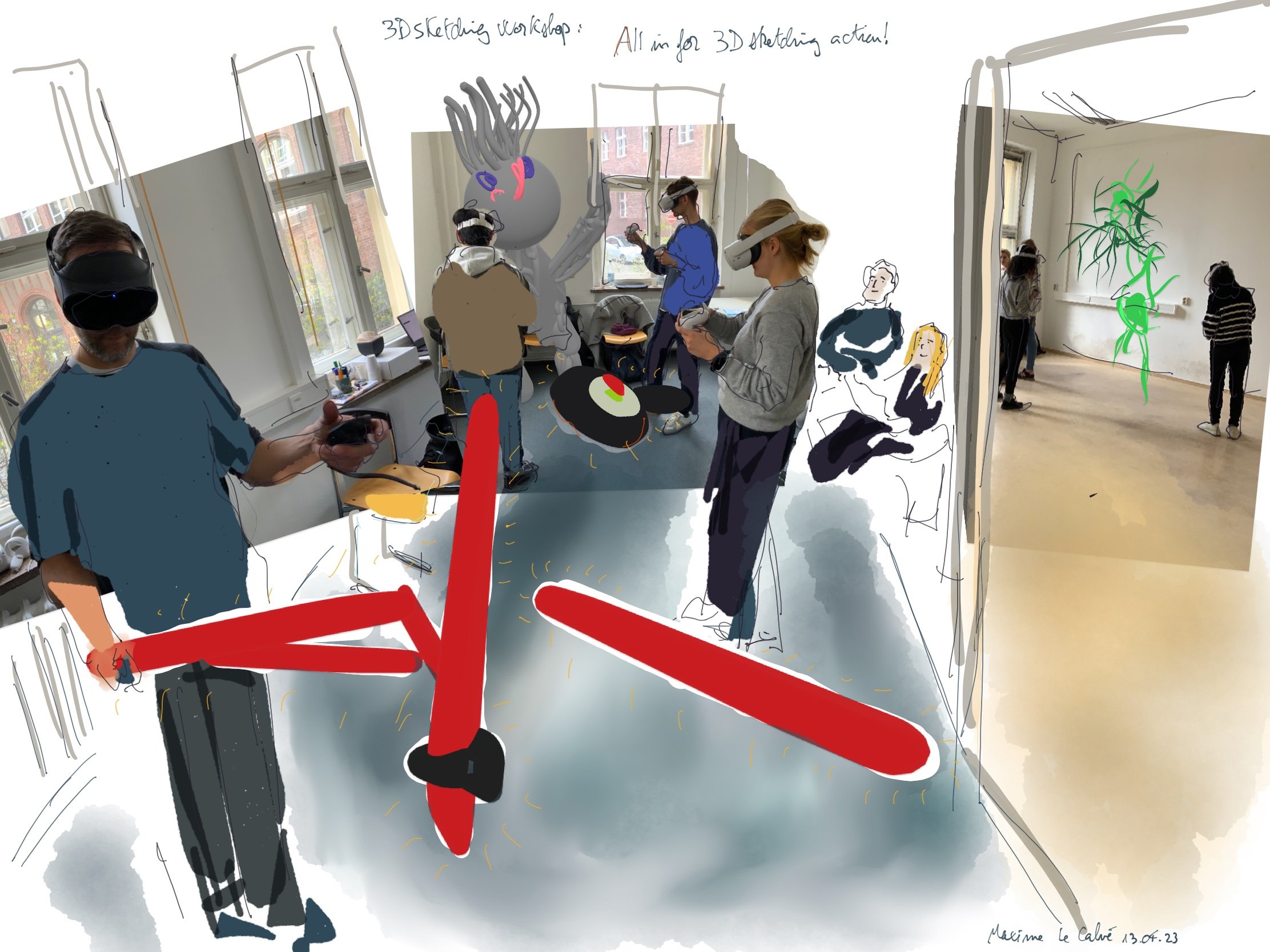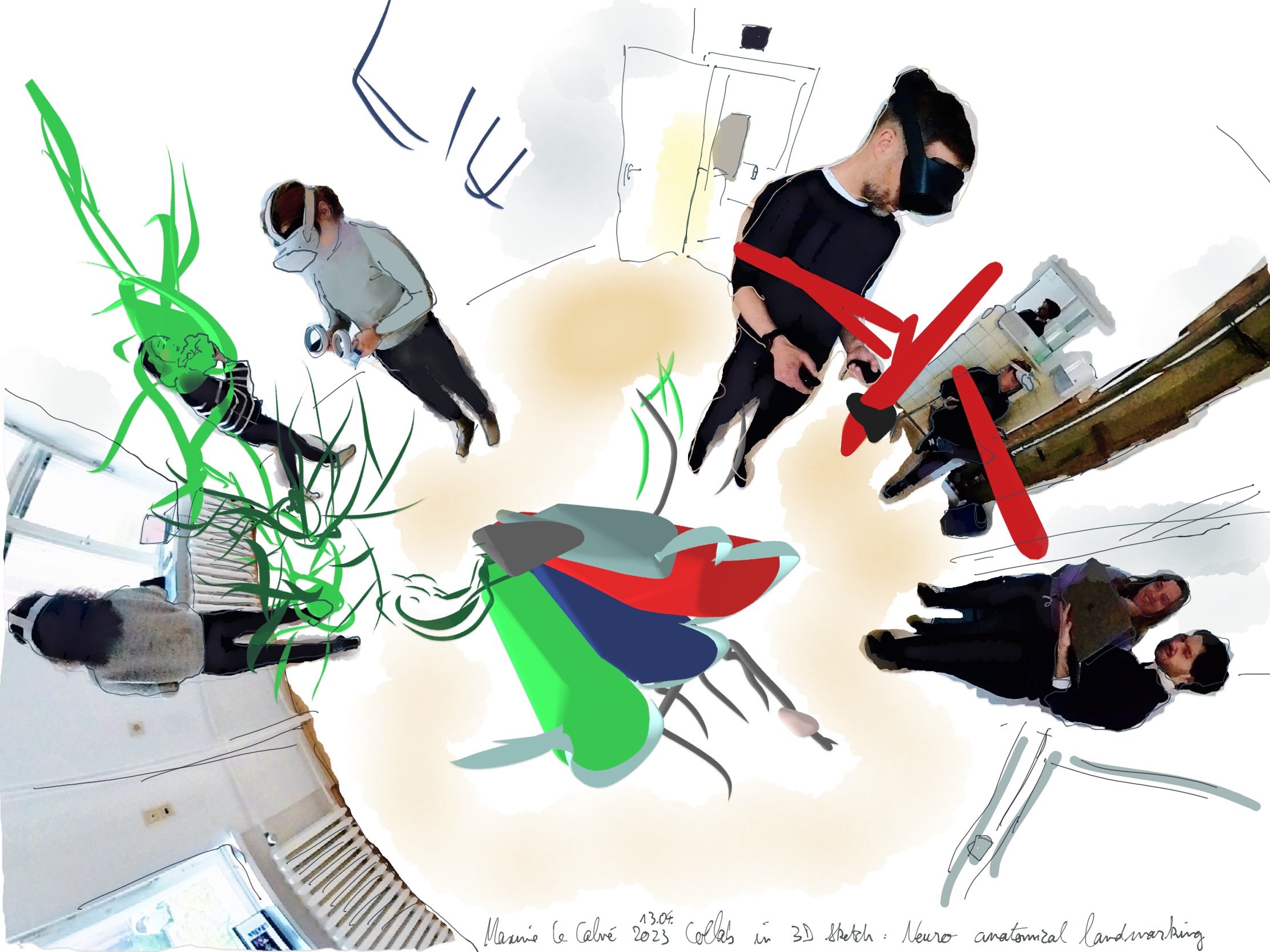How does the sense of space, and the haptic creativity associated with it, affect the teaching of anatomical knowledge? How can current practices be explored by shifting them to other techniques? In this first workshop of the SpecLab, together with HCI scholar Paulina Greta Stefanovic and neurosurgeon Thomas Picht, we challenged a group of participants from neurology, neuroscience, computer science, clinical linguistics, design and art to tell us "anatomical stories" using a 3D sketching tool. After a short introduction to the research project and a short tutorial, the participants jumped into the 3D sketching action using the free program Gravity Sketch.
The technological infrastructure was difficult to deal with at first, but with some inventive ways of overcoming a problematic internet connection, we were able to have participants share virtual rooms while moving around the same physical space. The new SpecLab space is a perfect playground for collaborative 3D sketching interactions. We hope to keep it as empty and spacious as possible. With the pass-through technology of the newer standalone headsets, we didn't have to worry about collisions. This gave the typical virtual reality technology a hint of what augmented reality might look like: the user is no longer alone, secluded in the headset. A wide range of shapes and materials were tried out that day, from arterial visualisations to images of neural forests and cartoon characters.
The last part of the workshop was a "hot seat" situation without a seat: several participants volunteered to tell us the stories they had created in the 3D sketching tool. Cathy, the first participant who took the floor, started with the sketch she had made: a view of the cortex and a sketch of the hypothalamus. She explained the manipulation she is currently doing in the lab, as part of a team working on the treatment of epilepsy. I then asked her to do it again, this time sketching the story 'live' as she went through the same narrative sequence. After a little hesitation ("it wouldn't be optimal"), she responded beautifully to the challenge and sketched the elements of her demonstration again in real time. That was fun! She seemed quite happy with her performance (despite an obvious preference for a cleaner 3D image that could be imported, she said). It was an exciting first result.
Next up was visual artist Vinh, a student at KHB Weissensee. He began by changing the scale with a majestic gesture: the previous cortex sketch became a small dot in 3D space, and he immediately began drawing a folded piece of paper in the air. "This," he told us enthusiastically, "is how I get students to engage with art in museums". The students start by folding a piece of paper, then draw a part of an image they like in the exhibition and pass it on to another person who continues the drawing without knowing the previous part. Vinh demonstrated how this works by drawing in this mode for a few minutes while talking about his pedagogical work in this context.
This was a very relevant conceptual contribution to the workshop, as we were discussing different ways of making learning processes more engaging through sketching techniques. I personally felt that he was still sketching in 2D - but he started using 3D extruded shapes and then it became really interesting. What if we introduced the use of 3D sketching for museum visits, we asked ourselves in the final discussion.
This shift from flat to spatial was an important theme throughout the session: participants described tricky anatomical structures in the brain that could not be guessed from 2D images (Thomas), or drew spatial representations of neurons from historical sources to illustrate a conversation about degenerative diseases (Wendy).
Some of the participants had to be "put on the spot" to perform in front of the audience. Linda, a student on the UdK Product Design Masters programme, happened to be particularly graphically eloquent with her 3D technique. She first announced an omelette, but seemed to change her mind at the start of the narrative sequence and ended up demonstrating how to cook an egg, sunny side up, "with ketchup". Linda was obviously more familiar with 3D tools: she made an egg with a brush that creates circular shapes, and asked us how to duplicate objects (she ended up sketching every single pan). This humorous final story said a lot about the nice atmosphere that the sketching activity had created in the group: an openness that is not always easy to emulate.
In the final discussion, we reflected on the different modalities of learning through sketching - for example, sketch mapping as a way of learning a cartographic representation by drawing it many times. Sketching can be a way to disrupt the perfectionist glow of the 3D material used in scientific imagery and bring the focus back to the performance itself and the many ways it brings people together.
Special thanks to Milena Burzlaff for the amazing support!





